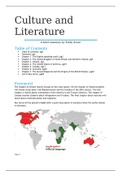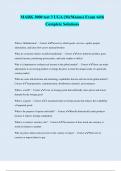Culture and
Literature
A brief summary by Emily Arenz
Table of Contents
Table of contents, pg1
Foreword, pg1
Chapter 1. The English speaking world, pg2
Chapter 2. The United Kingdom of Great Britain and Northern Ireland, pg5
Chapter 3. Ireland, pg7
Chapter 4. The United States of America, pg10
Chapter 5. Canada, pg17
Chapter 6. Australia, pg20
Chapter 7. The Second Dispersal and the Origins of the British Empire, pg24
List of Key terms, pg28
Foreword
The chapter on Britain mainly focuses on the class system. On the chapter of Ireland students
will mainly study about Irish Republicanism and the troubles of the 20th century. The USA
chapter is mainly about colonization of the America’s and Trump’s America. The chapter of
Canada teaches students about bilingualism and Trudeau. The final chapter about Australia will
teach about multiculturalism and migration.
Key terms will be placed in bold (with a quick description in brackets) when the author deems
is necessary.
Figure 1
, 1.The English speaking world
The world Atlas estimates that 1.39 billion people speak English. It is the most learned foreign-
and second language. In this book (summary) we’ll be looking at countries that speak English as
L1 language (first learned/acquired language, usually the mother tongue) and countries that
have historically used English, but not necessarily anymore.
,English is a West Germanic Language (a family branch name for languages that derive from
west northern Europe, see figure 2 and 3) in the Anglo Frisian language group.(see figure 4)
Figure 3
Figure 4
, Figure 2
English is most related to Frisian, followed by Dutch
and German as you can see in figure 3. It was brought
to the British isles in the 5th century from Germanic
tribes that invaded from what is now known as
Germany and Denmark.
Anglo Saxon or Old English (the first form of English)
first changed when Vikings (pillagers from the north
wearing funny hats) invaded in the 9th century. It
changed again when Normans (French speakers from
Normandy) invaded in 1066, A.K.A. the 11th century.
Meaning English derives from many Scandinavian and
Norman French words.
The Norman French changed the language so much, that the language is called Middle English
(the second form of English) after their conquest. Middle English differs greatly from Present
Day English (Also known as late modern English, the fourth and final form of English) but it is
comprehensible to us. Shakespeare English known as Early Modern English (not quite what we
speak today, but very close. The third form of English) is quite easy for us to understand,
perhaps a bit odd though.
At the height of the British empire in the 1800s, there was a saying: “The empire on which the
sun never sets”. By the 19th century it was the most used language for commerce. Jeremy
Harmed noted that there are five main reasons for English’s world dominance.
1. Colonial History (Where’s Waldo in reverse, cause where ain’t they been?)
2. Economic (Coca-Colonization)
3. The exchange of information (internet stream from USA)
4. Tourism (it’s most used for travel, recreationally)
5. Pop Culture (movies, music, musicals, theatre, etc)
Because of this necessity for English there are new types of language learning like ESP (English
for special purposes, L2 specifically focused on the field these people work in) and EOP
(English for occupational purposes, L2 specifically for business language). I’m also adding EAP
(English for academic purposes, to study the language for different academic purposes).
According to World Atlas 480 million people speak L1 English. This is the group we’ll mainly be
focusing on, and is also known as the Anglosphere (see figure 1, Most definitions include
Australia, Canada, New Zealand, the United Kingdom, and the United States. The term can also
encompass the Republic of Ireland and English-speaking Caribbean countries such as The
Bahamas, Barbados, and Jamaica.) Most spoken in the USA by 325 million people, followed by
Britain with 66 million people. In the Netherlands British English is often used for their norm of







